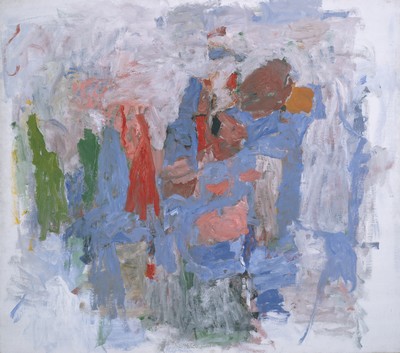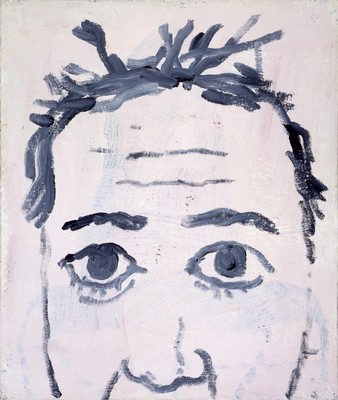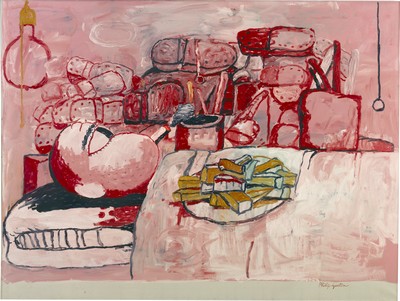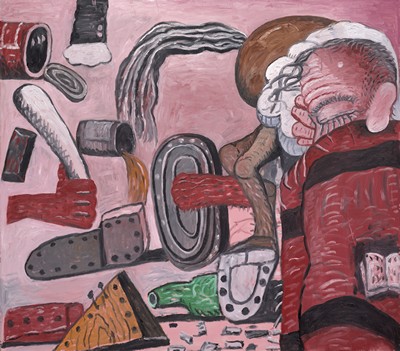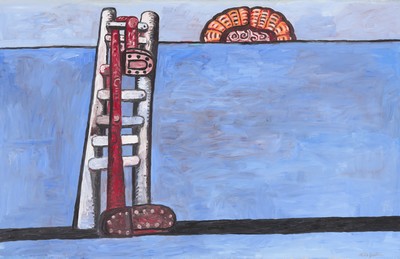Philip Guston Now
National Gallery of Art, Washington, DC
March 2 – August 27, 2023
Nude Philosopher in Space-Time, 1935
oil on canvas
overall: 116.21 × 62.87 cm (45 3/4 × 24 3/4 in.)
Private Collection
© The Estate of Philip Guston
Passage, 1957-1958
Oil on canvas
Overall: 165.1 × 188.6 cm (65 × 74 1/4 in.)
The Museum of Fine Arts, Houston.
Bequest of Caroline Wiess Law, 2004.20
© The Estate of Philip Guston
One of America's greatest modern painters, PHILIP GUSTON (1913–1980) bridged the personal and the political, the abstract and the figurative, and the humorous and the tragic in paintings of lively touch and memorable impact. A major retrospective of the artist, Philip Guston Now, presents of the full scope of the artist's 50-year career. Organized by the National Gallery of Art, the Museum of Fine Arts, Boston, Tate Modern, London, and the Museum of Fine Arts, Houston, the exhibition is on view in the National Gallery's East Building from March 2 through August 27, 2023. The exhibition will then travel to Tate Modern, which will be its final venue.
“Philip Guston has inspired generations of artists—not just for his remarkable paintings, but also for his courage. We hope this complete look at Guston’s career connects a wide audience with his art’s power and continued relevance,” said Kaywin Feldman, director, National Gallery of Art. “We are grateful to the many people, both inside and outside the museum, whose voices have challenged, guided, and inspired us as we prepared our presentation of the exhibition. The lessons we’ve learned and new processes we’ve implemented will allow us to better fulfill our mission of serving the nation in all its complexity.”
The presentation at the National Gallery will include approximately 110 paintings and 115 drawings from some 40 public and private collections—the largest presentation among the four venues, with more than 30 paintings and drawings on view only in Washington. Also unique to the museum’s presentation is a separate installation on the East Building Ground Floor of all 73 drawings from Guston’s series of Poor Richard drawings, inspired by the life and career of Richard Nixon, which are a promised gift of the Guston Foundation to the National Gallery of Art.
Related programs offer both in-person and virtual opportunities to get inspired by Philip Guston's art. A conversation on Guston’s public artworks is also a rare chance to see one of his largest commissioned murals, The Reconstruction and Well-Being of the Family (1943) in the Wilbur J. Cohen Federal Building in Southwest DC. Other offerings include a virtual studio that invites participants to make their own artistic creations.
Since the exhibition’s postponement in 2020, the National Gallery has been broadly rethinking its exhibitions processes, including how to meaningfully engage a wider range of perspectives. Among these are the voices of external advisors, including thinkers, artists, educators, and community leaders, and internal advisors, including staff most directly involved with the public. These conversations, framed by the National Gallery’s people-centered mission, vision, values and strategic priorities, have generated new insights into the impact of our work, and have influenced interpretive, design, and operational decisions, including the opening date of the exhibition. The new opening date of March 2, 2023, rather than February 26, 2023, allows more time for training and conversation for front-facing staff and also addresses concerns about opening the exhibition during Black History Month.
Untitled, 1968
Acrylic on panel
Overall: 49.53 × 41.91 cm (19 1/2 × 16 1/2 in.)
Private Collection
© The Estate of Philip Guston
Untitled (Shoe), 1968-1973
Oil on panel
Overall: 24.77 × 30.48 cm (9 3/4 × 12 in.)
Private Collection
© The Estate of Philip Guston
Poor Richard (no. 37), 1971
Ink on paper
Overall: 26.67 × 35.24 cm (10 1/2 × 13 7/8 in.)
The Guston Foundation
© The Estate of Philip Guston
Painting, Smoking, Eating, 1973
Oil on canvas
Overall: 196.85 × 262.89 cm (77 1/2 × 103 1/2 in.)
Stedelijk Museum, Amsterdam
© The Estate of Philip Guston
EXHIBITION HIGHLIGHTS
Philip Guston Now charts the 50-year career of one of America’s most influential modern artists. The exhibition follows Philip Guston’s epic, winding career as he changes artistic styles, explores abstraction, moves in and out political involvement, and finally arrives at the dark, tragicomic imagery of his late work.
Following a new short biographical video, the exhibition begins with Guston’s Painter’s Table (1973), a promised gift of Ambassador and Mrs. Donald Blinken to the National Gallery. This “painting about painting” features various motifs Guston used in his late works—cigarette butts, books, an eyeball, shoes, irons, a lightbulb, and spikes.
The exhibition continues with works Guston made at the beginning of his career in the 1930s and 1940s, including early forays into politics and contemporary events such as Bombardment (1937), from the Philadelphia Museum of Art, made in response to the April 1937 Nazi bombing of the Spanish town of Guernica. Philip Guston’s progress toward abstraction is shown in such pivotal examples as The Tormentors (1947–1948) from the San Francisco Museum of Modern Art.
Next comes a presentation of Philip Guston's abstract period—a rich group of some 20 paintings and drawings made between 1950 and 1965 showing his embrace of abstract expressionism (the dominant tendency in New York at the time), followed by his growing doubts about that movement. This gallery includes several works not seen at the previous venues, including Native’s Return (1957), from the Phillips Collection, and The Return (1956–1958), from Tate Modern.
The experiments that gradually brought Philip Guston all the way back to figuration are represented by a dazzling array of some 50 small works made between 1966 and 1972, including what he called “pure” drawings and “object” drawings, in which he developed his new vocabulary of hoods, books, bricks, and shoes. These objects would appear in the large-scale paintings that were displayed in his groundbreaking Marlborough Gallery show in 1970.
The Marlborough show was shocking at the time for Philip Guston’s abandonment of abstraction in favor of a raw, cartoony figuration—but today it is the paintings’ anti-hero, a hooded Ku Klux Klan figure, that grabs our attention. Guston was impelled to return to this figure, which had first appeared in his protest art of the 1930s, by Vietnam War and civil rights demonstrations that triggered childhood memories of Klan racist violence and police brutality.
As Guston contemplated his own unwitting complicity in the injustices of his time, he made “self-portraits” of artists in Klan hoods in works such as The Studio (1969). Philip Guston Now includes the largest reunion of paintings from his pivotal Marlborough Gallery show—in total 12 of the original 33 paintings shown. At the National Gallery these include the imposing Courtroom (1970), from the Robert and Jane Meyerhoff Collection.
Legend, 1977
Oil on canvas
Overall: 175.26 × 199.39 cm (69 × 78 1/2 in.)
The Museum of Fine Arts, Houston.
Museum purchase funded by the Alice Pratt Brown Museum Fund, 88.35
© The Estate of Philip Guston
The Ladder, 1978
Oil on canvas
Overall: 177.8 x 274.3 cm (70 x 108 in.)
National Gallery of Art, Washington, Gift of Edward R. Broida
© The Estate of Philip Guston
The final three rooms of the exhibition present a powerful selection of large, often symbolic and confessional paintings of the later 1970s that form the artist's last major artistic statement. Works in this section only on view in Washington are The Street (1977) from The Metropolitan Museum of Art; two related paintings, Balance (1979) and Reverse (1979), from private collections; and seven smaller single images (a sandwich, a pile of cherries, a kettle) in acrylic and ink made in 1980 in Philip Guston's final days. In an adjoining auditorium visitors can watch Michael Blackwood’s 1982 documentary, Philip Guston: A Life Lived, which features extensive interviews with the artist.
Upstairs, a separate installation displays the full set of Philip Guston’s Poor Richard drawings, a promised gift to the nation from the Guston Foundation. Conceived by the artist as a book, the satirical drawings of Richard Nixon and his associates were unpublished during his lifetime. These galleries also include the only painting the artist made of Nixon—San Clemente (1975), from Glenstone Museum—and City (1969), a promised gift of Musa Guston Mayer to the Metropolitan Museum of Art.
EXHIBITION DATES
Museum of Fine Arts, Boston, May 1–September 11, 2022 Museum of Fine Arts, Houston, October 23, 2022–January 15, 2023 National Gallery of Art, Washington, March 2–August 27, 2023, Tate Modern, October 3, 2023–February 25, 2024
EXHIBITION ORGANIZATION
The exhibition is organized by the National Gallery of Art, Washington; the Museum of Fine Arts, Boston; Tate Modern, London; and the Museum of Fine Arts, Houston.
EXHIBITION CURATOR
The National Gallery of Art’s presentation of Philip Guston Now is organized by Harry Cooper, senior curator and head, department of modern and contemporary art.
PUBLICATIONS
PHILIP GUSTON NOW
Published in 2020 by the National Gallery of Art and D.A.P./Distributed Art Publishers, Inc., Philip Guston Now includes essays by the exhibition's co-curators and leading art historians; a detailed chronology of the artist’s life and work based on new research; and reflections by 10 of the most daring contemporary artists on their engagement with Guston and the impact of his work and legacy.
Also released in 2020, Poor Richard by Philip Guston publishes the artist’s 73 satirical, imaginative drawings of Richard Nixon, Henry Kissinger, Spiro Agnew, and John Mitchell, including an original title page. Conceived as a book, the drawings were unpublished during Philip Guston’s lifetime were not exhibited until September 2001.
Both publications are available at shop.nga.gov
NATIONAL GALLERY OF ART
Sixth Street and Constitution Avenue NW, Washington DC


